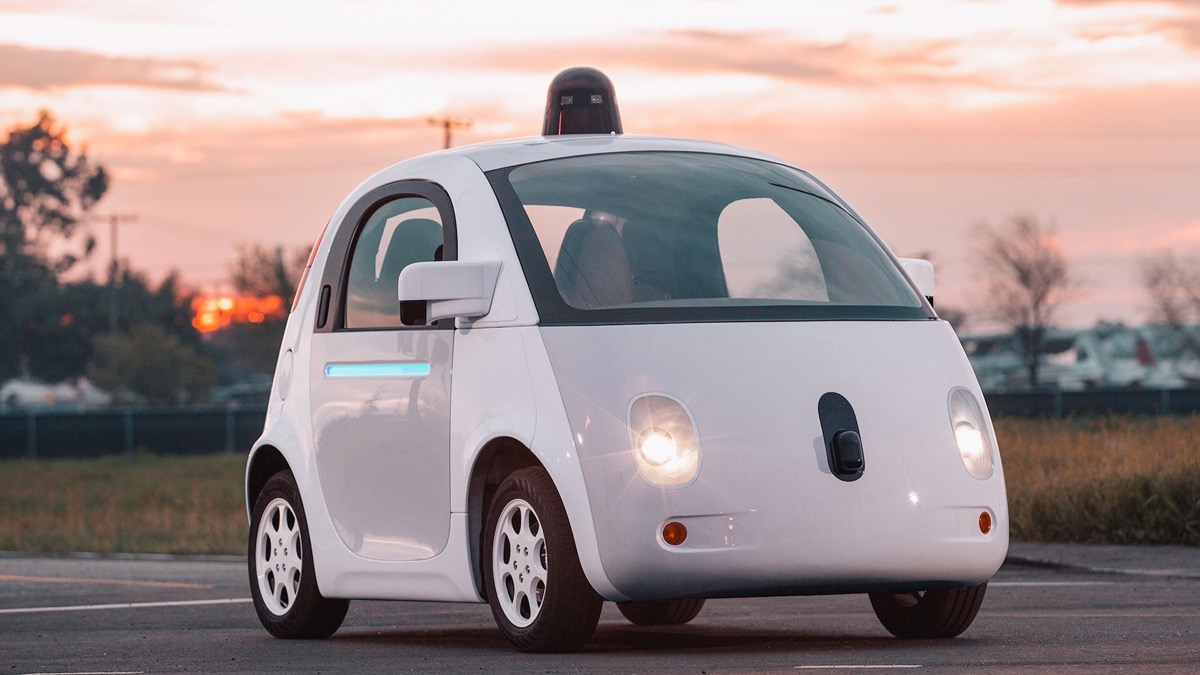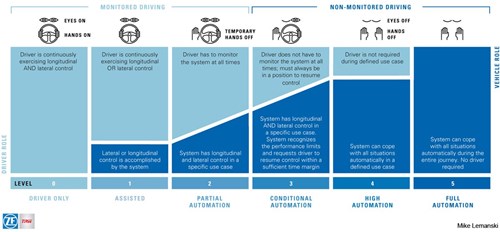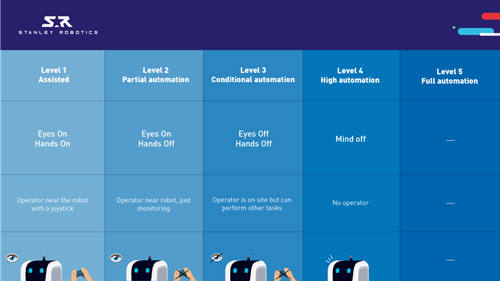
Car manufacturers have been working on driver assistance systems since the 90s - when autonomous driving existed only in science fiction movies or books. In the coming decades, the automobile industry will completely transform itself and make great leaps compared to the developments of the last thirty years. Today we are entering a new era, that of highly automated driving.
Autonomous driving is no longer the stuff of fiction, it is becoming a reality. In recent years, many companies have announced their wish to participate in this race towards the fully autonomous car.
To better understand how our robots are comparable to autonomous cars, it is first necessary to know the different levels of automation commonly used by the automotive industry (even if variants of these exist). Understanding these levels also helps to better understand the state of play of the various actors on the subject.
Level 0 - No Automation
As the name implies, at level 0 the driver performs all the tasks himself.
Level 1 - Driver Assistance
Depending on different criteria, the car can control steering or speed but not simultaneously. The driver assumes full responsibility for the control of the car and must regain control if the system fails. These include, for example, brake assist (ABS) or handling (ESP) systems.
Level 2 - Partial automation
At level 2, the driver remains responsible and must be ready to take control at any time. The vehicle can at the same time manage the driving, regulate the speed and brakes.
The Tesla Autopilot or the Valeo park assist are good examples of level 2 autonomous driving as well as the speed stabilizer. It is known as "Hands Off" in English meaning that the driver can intermittently, and in special cases, release the steering wheel or pedals.
Level 3 - Conditional automation
In a Level 3 vehicle, some modes take full control in certain driving environments and phases, but the driver must be able to regain control if the car requires it. The car can change lanes by itself and react according to events that occur around it. However, this level is very often neglected by manufacturers who try to go directly to level 4, because they consider it too risky for people in the car (many studies have shown that partial autonomy can be very difficult for drivers to understand).
The typical example of level 3 is the autonomous car driving on a highway but which is unable to coordinate arriving at a toll; it requires a few tens of seconds of advanced warning before the driver can intervene. If the driver doesn't intervene, the car is able to drive itself to safety, by using the emergency stop function for example.
This is called the "Eyes Off" function meaning that the driver can intermittently, and under some special cases, no longer pay attention to the road.
Level 4 - High automation
A level 4 vehicle is a vehicle that can move autonomously on a particular trajectory and under specific conditions that are generally made known in advance. On a given trajectory (for example on the highway, on a known route), the driver does not need to be behind the wheel and can take his attention away from the road. This level is also called "Mind Off".
Level 5 : Full automation
Level 5 is what you’ve been seeing in anticipation movies for many years. It's when you get in your car in the morning, that it drives you to your job, while you quietly prepare. The car can move on any type of road and under any conditions since it can adapt to its environment. It's called the "Driver Off" level.
No car manufacturer has yet reached the level 5.

Stanley Robotics and autonomous driving
At Stanley Robotics, as we are sure you are aware, we manufacture autonomous robots. And if you are wondering if the above applies to our service as well, the answer is yes.
In actual fact, our robots have many technical characteristics common to those of autonomous cars. The environment in which they operate is not exactly the same at the moment, as they are currently intended to move in enclosed car parks, but the technology is similar.
We made the choice to operate our first robotic service in a closed environment; closed to the public. Unlike cars, which are subjected to the open road and to many regulations and constraints, we are able to develop much higher levels of autonomy much more quickly.
The following levels of automation applied specifically to our service could be presented as follows:
Level 1 - Driver Assistance
Most of the movements are made by joystick. In order to lift a vehicle, once it has come into contact with the wheels, the robot can only make the movements necessary to that task.
Level 2 - Partial automation
The robot can perform all of its tasks autonomously. An operator actively supervises the robot while performing its manoeuvres and intervenes when needed.
Level 3 - Conditional automation
An operator is present to supervise but the robot can be trusted to operate autonomously and will alert the operator if necessary.
This gives the operator the ability to monitor multiple robots at once. If an unknown problem arises, the robot will not make a decision, it is the operator who will decide what action to take.
Level 4 - High automation
The robot is itself capable of overcoming obstacles and unknown situations in the car park. There is no need for an operator to supervise the system and the entire service has become entirely autonomous.
Level 5 : Full automation
Level 5, to summarize, is level 4 but the robot can leave the car park and move freely on the open road, at a reduced speed. For example, he could pick up a car from directly in front of the terminal.

Stanley Robotics: Accelerated Road to High Automation
Our robots are rapidly evolving and will have reached level 3 by next summer. We will then be one of the first companies in the world to reach level 4 outdoors, on a large scale, and on a fully commercial and open to the public service. The fact that we are in a closed environment closed to the public will allow us to reach this level much more quickly.
By quickly and autonomously managing car parks with several thousand spaces, we will develop a solid base to prepare for level 5.
The real challenge of the industrial robotics service is excellence in operation.
By being already operational to the public, Stanley Robotics every day generates a little more experience in running robots independently in all outdoor conditions (rain, mud, fog, snow, mulch ..). It also allows us to successfully meet the major challenge of providing the high-quality service rates expected by the industry. Thanks to this, Stanley Robotics will quickly become a global champion of the emerging market of Robotics-As-A-Service.
About Stanley Robotics
Stanley Robotics is a venture-backed company that was created in January 2015, and is  headquartered in Paris, France. It is developing an automated valet parking service with robots that can move any vehicle and increase capacity in existing car parks by up to 50%, while revolutionizing the user experience.
headquartered in Paris, France. It is developing an automated valet parking service with robots that can move any vehicle and increase capacity in existing car parks by up to 50%, while revolutionizing the user experience.
The three founders, Clément Boussard (CEO), Aurélien Cord (CTO) and Stéphane Evanno (COO), all have previous experience in driverless technology (at top research institutes and with a world-class industrial corporation).





